---------------------------------------------------------
Alpacas are a fun and fluffy addition to a small farm. They provide plenty of rich manure to feed your gardens and of course, have all that wonderful fiber that can be sold or spun into useful items. How much will it cost to get your yard ready for alpacas and to maintain a small herd?
Set Up Costs
The cost to get your area set up for alpacas depends greatly on where you are starting from. If you have a fenced field and large shed you are most of the way there!
Alpaca Fencing
A securely fenced-in area is the most basic and necessary requirement. Older, less active alpacas can be contained by a four-foot fence. A 5 or 6-foot fence is a better option. Alpacas generally don’t challenge a fence like goats would. They are more or less happy to hang out and graze in the area they are given. Some reasons an alpaca might try to jump a fence include looking for a mate, or trying to escape a bully alpaca or predator.
You will want to plan for about 1 acre of land for every 6-7 alpacas. This is enough space to allow them to graze without stripping the field and will give them plenty of room to spread out to avoid fighting. The less land you give your alpacas for grazing, the higher your costs will be for hay.
If you plan to keep male and female alpacas they will need separate grazing areas & shelters so that the females will not be overmated, leading to injury. If you intend to breed, you will need even more separate areas. You will want a pasture for females, one for older males, and one for younger males or weanlings. This will greatly increase your fencing costs.

Alpaca Shelter
Your alpaca shelter is the next area where costs can vary greatly. You might have an old shed or barn that can be converted, or you could be starting with nothing. Alpacas enjoy being outdoors and most don’t like being contained inside. Many alpaca owners allow their animals to sleep in the fields. You will still need to provide some type of shelter from wind, snow, and sun, however.
We have a horse barn where our alpacas have three stalls and are secured inside at night. For the three alpacas, the space is 10×30 plus a hallway. This is oversized, we could probably keep twice as many alpacas in here but wanted to give ourselves room to expand. They are turned out in the morning to the paddock but the barn is left open so they can return anytime they like. Another option is a simple run in shelter. This shelter is usually three-sided so the alpacas simply use it to escape the elements as needed.
Equipment
You will need a wheelbarrow, shovel, and rake for cleaning stalls and the field. Alpacas are clean animals who only poop in one or two locations. This makes cleaning fast, you don’t have to search the field to clean, just simply scoop up the dung pile.
Buckets for feed & water will be needed, as well as a hay manger that can hold a bale of hay. A metal trash can for storing unused pellet feed and space for extra hay bales will also be helpful. If you live in a climate that freezes, you will want to have a heated bucket to keep their water liquid in the winter. Electricity is helpful to have installed in the barn but is not needed. You can run a long outdoor extension cord from your home. A barn fan is another nice thing to have, especially if you live in a warm climate. Not only will it keep the air moving and cool your animals in the summer, but it can also help keep flies away.
Grooming Supplies
The number of supplies you will need depends on how hands-on you will be. Will you be hiring someone to trim their toenails? Will you be doing the shearing yourself? How comfortable are you with administering shots?
Alpaca toenails need to be trimmed every 3-4 months. With practice, you can learn to do this yourself with some sharp by-pass shears. If you will be hiring someone to attend to their nails, you will not need to purchase these. I would highly recommend you have a professional show you the proper way to do this. Removing too much of the nail can cause bleeding and infection, or misshapen nails.
Many alpaca owners have a professional shearer come out once a year to shear their alpacas. This is another skill you can eventually learn yourself. If you shear your own animals you will need shears, a mat, and restraints or a chute to keep the animal safe & still while shearing. Most professional shearers will also trim your alpaca’s teeth during their visit. If you will not be hiring a shearer you should also plan to purchase a tooth grinder.
Buying the animals
There is a huge range of costs involved when acquiring alpacas. You might be able to find some older rescue alpacas for a few hundred dollars, you could spend $20,000 on a premium stud, and anywhere in between. The cost of the alpaca depends on several factors – the quality of fiber is usually the most important, followed very closely by pedigree. If an alpaca comes from a line of show quality, award-winning alpacas expect to spend at least $7,000-$10,000 if not significantly more. When breeding alpacas you should invest in the highest quality animals that you can afford. If you simply want a pet or fiber you could certainly find less expensive alpacas.
Generally, males are less expensive than females of similar quality. Alpacas can live for 18-20 years, if they are over 10-12 years old you can expect to pay less. A proven male or female (one that has sired or birthed a baby) are more expensive than maidens or juniors. If the farm is not close to you, there will likely also be a transportation fee to get the alpaca delivered to you. Openherd.com is a good place to start when looking for local farms with alpacas for sale.
Ongoing Costs of Maintaining Alpacas
We have a small flock of just 3 alpacas – here are the costs we generally incur on a regular basis.
Hay – About $25 per month, per alpaca – Hay and grass make up nearly all of an alpaca’s diet. If you don’t have good quality grass in your field or not enough of it, you will need to buy more hay to supplement. They are very efficient eaters, cycling food through the three chambers of their stomach to extract every bit of nutrition. In winter you will likely go through more hay when your fields are dormant. If you can buy and store large quantities of hay you can greatly reduce your cost. I only have the space to store a month or two at a time so can not buy in bulk. I would say on average our 3 alpacas go through 1.5 bales of hay per week when averaged out over the entire year.
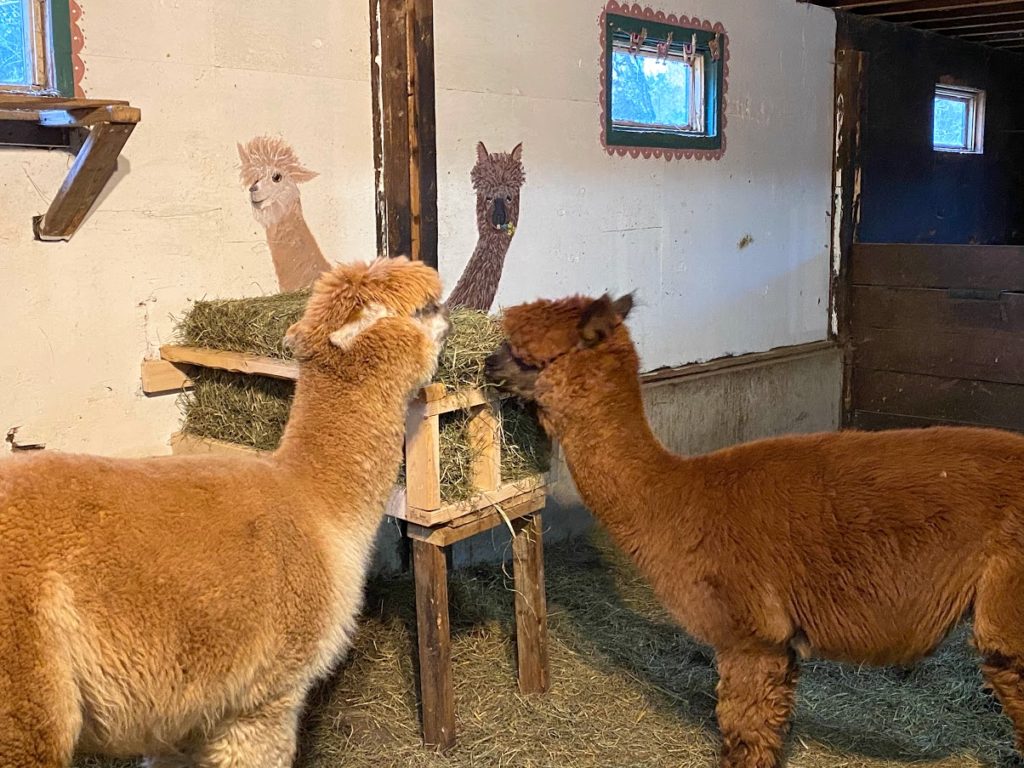
Pellet Feed – About $4 per month, per alpaca – Alpacas are native to the Andes Mountains. Because I do not live in South America my grass & hay likely do not have the wide range of minerals and nutrients found in the Andes that alpacas thrive on. Most alpaca owners supplement their diet with pellet feed. Each full-grown alpaca will need about 1 cup of pellets per day.
Loose Minerals – $1.50 per month, per alpaca – In addition to the pellet supplement we also offer free choice loose minerals. We get ours from Stillwater Minerals. They make a high quality salt, mineral, & vitamin blend especially made to keep alpacas healthy! Their 11-pound bag lasts us just over a year and is currently $52 which works out to about $1.50 per alpaca per month.
Ivermectin injections – $2.50 per month, per alpaca – In most parts of America, your alpacas will need monthly injections of Ivermectin to protect them from meningeal worms (click here to read more about this). Because it is not practical to have a veterinarian visit the farm every month, we administer this ourselves. In order to do this we need injectable Ivermectin and a disposable 3 cc syringe with 20 gauge needle for each alpaca. You can find these supplies at many feed stores or veterinary supply companies.
Nail Trimming -$60 per year, per alpaca – Alpacas don’t like to have their feet handled. Holding a 150 pound animal still for nail trimming is challenging! Because of this, we hire someone who knows what they are doing to trim our alpaca’s nails. Their nails need trimming every 3 months and costs us $20 per alpaca. Our shearer also does nails, so he does the summer trimming which means our nail trimmer makes 3 trips to the farm per year. I think it’s well worth it!
Shearing/Teeth Trimming – $80 per year, per alpaca – Once a year alpacas need to be sheared. This is an exciting time and you will be absolutely amazed at the amount of fiber each alpaca has! Shearing should be done in late spring/early summer. Alpacas can die of heat stroke if their heavy fiber coats are left on during the warm summer months so this is a necessary part of their care. Most traveling shearers will not only shear your animals, but will trim their teeth (which continue to grow throughout their lives), and will trim their nails all as one package. They are professionals who can get this job done in the fastest and safest manner possible to minimize stress on your alpaca. This costs us $80 per alpaca. Most shearers will give discounts if you have a really large herd.
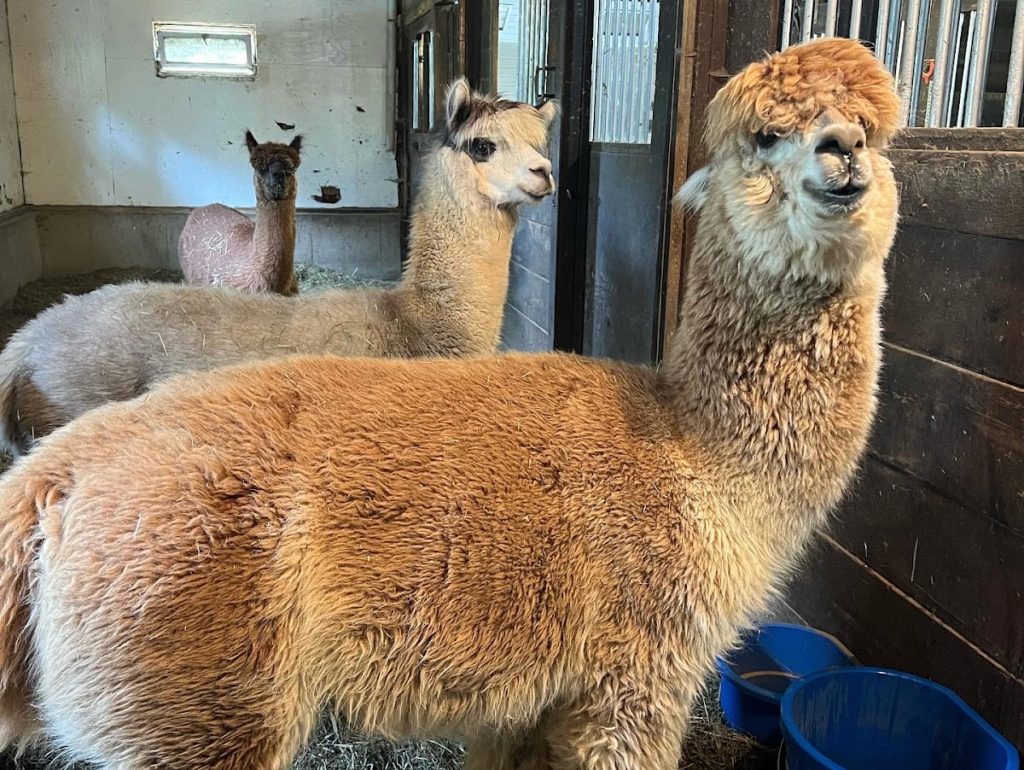
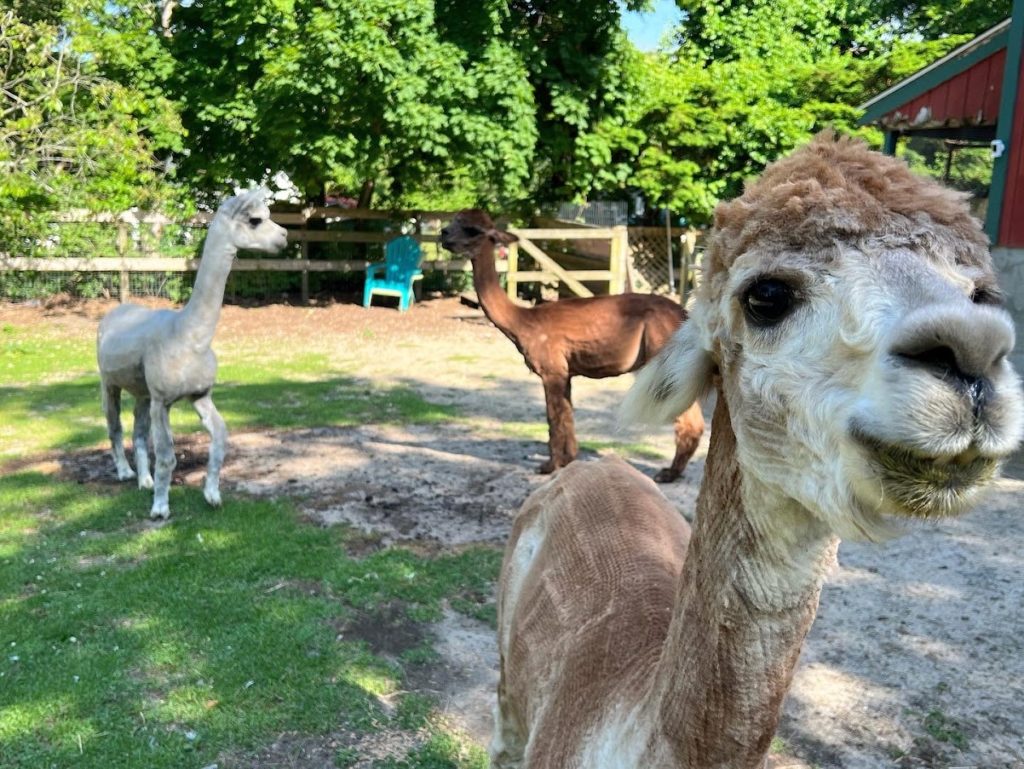
Veterinarian Check Up – $120 per year, per alpaca – Vet costs will of course vary wildly based on your region and if you have any health problems or emergencies. Our farm vet charges $120 per alpaca to come out to the farm and give them an annual exam which includes a rabies shot, CD-T shot (prevents bloat & tetanus), and BO-SE shot (a selenium and vitamin E booster). Your vet will recommend these or other routine vaccinations based on your area and care practices.
Fecal Testing – $36 per year, per alpaca – Three times per year we like to run fecal tests on our herd. This is the easiest way to catch parasites before they become a problem. We simply collect our sample from each animal and mail them off to the lab. this is the lab we use
Total Costs
If you add all of this up, the maintenance costs for our small herd come to $692 per alpaca, per year – or about $58 per month per animal. This of course is just a general average to give you an idea of what it might cost to maintain a small herd of alpacas in your yard. If you have several acres of pasture your hay bill will be much smaller. If you opt to learn how to do your own nail trimming and shearing that would also be a big savings. Be sure to take advantage of all that wonderful fiber! Selling the raw fiber or spinning it into yarn for socks, gloves, or hats can go a really long way in covering your maintenance costs!
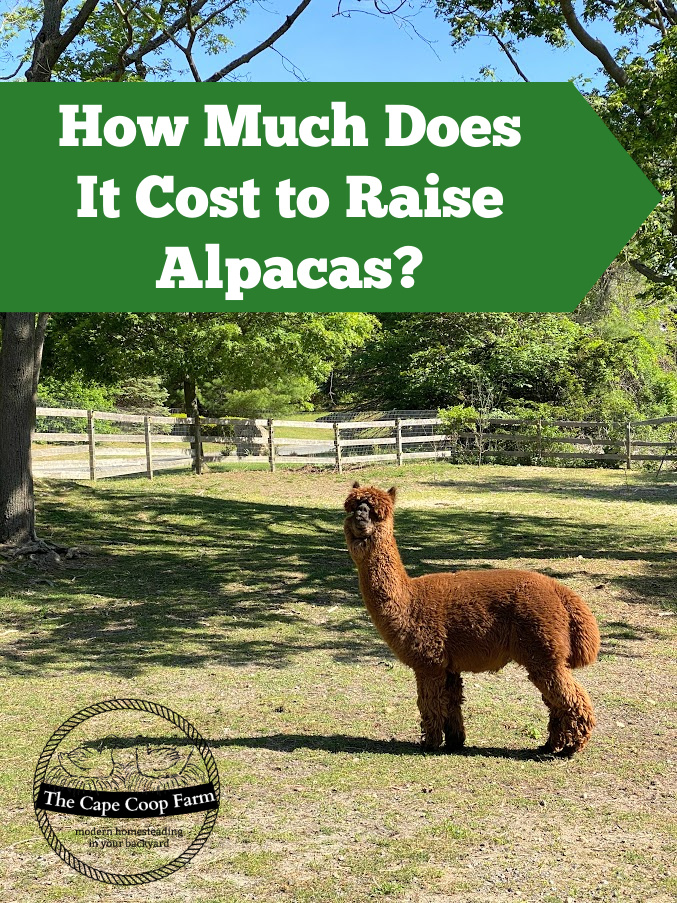

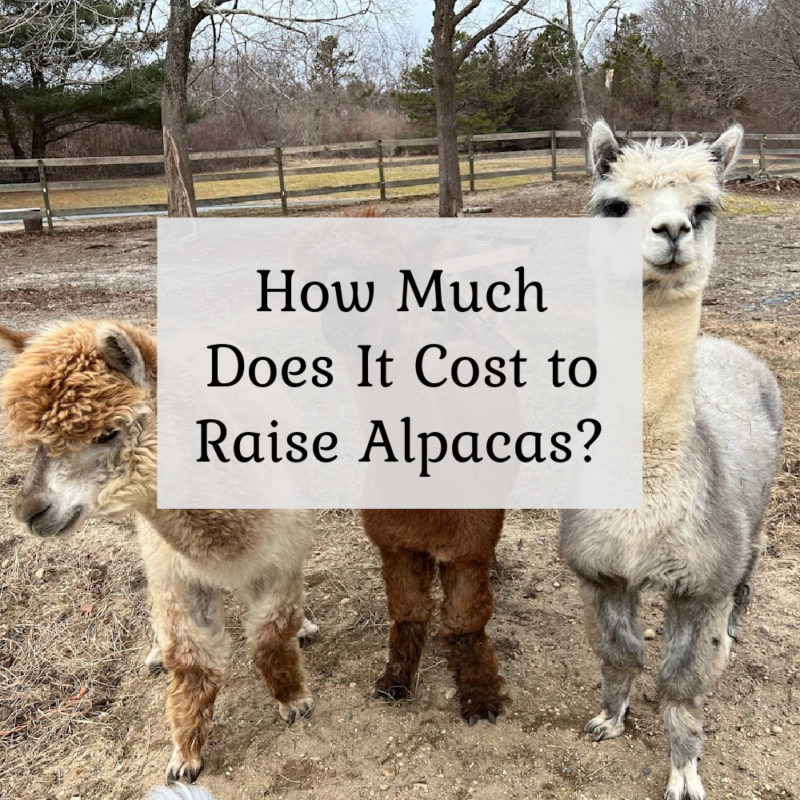

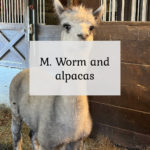
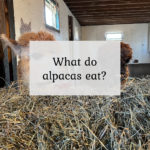
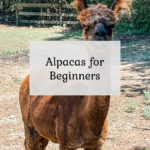
Paul
Friday 10th of March 2023
Excellent article Liz… Lots of great info… Thank you!
I’m also wondering how much money you can expect to get per animal if you were to sell the raw fiber. Kinda like a general estimate of average quantity and average price for that per average animal (pre-processing, just an average ballpark).
I am not a fan of Ivermectin or any toxic wormers… I go with charcoal instead (and stool tests prove it’s working great for all my other livestock)… Chemical wormers make the manure toxic and worthless… It will kill earthworms in the garden… So avoiding those is a must for me, and ivermectin is pretty bad as far as wormers go…
Also… I wouldn’t eat any animal that had been dosed with ivermectin… I have read that Alpacas are good for meat as well as fiber… I have yet to taste one, but that is worth considering. While that might horrify someone that only sees them as fiber pets, not everyone shares that bias (I love goat and sheep meat, and both can be fiber animals as well). The more uses you can get from an animal the better, (especially for homesteaders or small farmers).
Horse meat used to be more popular than beef, and eating them was outlawed because horses were needed for wars (WWI and other wars around that time)… Many generations have grown up since, without horse meat on the menu, so they don’t know that it was once a very popular meat.
Horse is still on the menu in many countries, and some day I might get a chance to taste it for myself (granted I’m not in a rush, but would be interested in tasting it if I saw it on a menu).
Horse manure is problematic for many gardeners/farmers because most of the horses were treated with wormers (Ivermectin is the most popular wormer for horses too). If it were not for that ivermectin/wormers, horse manure would be in high demand (instead of toxic and difficult to get rid of).
There are better natural/organic options available for worming, and your animals will be better off with any of them. I recommend researching those other options, to figure out if they might be better for you and your animals.
I have briefly thought about raising Alpacas for a few years… I am a big fan of the fiber and the animals seem very cool as well… I still have to learn more about them before I commit (never take on a new animal without learning all about that animal and their needs… We can never be good stewards to anything we don’t know). Your article helped a lot… Knowing about teeth and nail care is good to know, as well as nutritional needs and vet care/owner care, as well as frequency. Thanks again… You Rock!!!
Liz
Friday 10th of March 2023
Thanks Paul! How much fiber you can expect per animal depends a lot on the quality & age of your alpaca. A young, well-bred alpaca might produce 10 pounds of prime fiber per year, whereas an older, low quality alpaca might only produce 1-2 pounds. The highest quality part of the alpaca is the "blanket" which is the fiber from its back & sides. The average blanket is about 4-6 pounds. A SUPER general estimate would be you could turn that into enough yarn for 15-20 pairs of gloves or socks. How much money you can make on fiber depends on where you sell it, and what your local market will support. You could get anywhere from $6-$20 per pound for the blanket, and about half as much for the 2nds (leg, and neck fiber, which is usually 3-4 pounds worth). Your profits will increase if you have the skill to spin it into yarn, and even more if you can turn it into a finished product. We sell all of our fiber to the New England Alpaca Fiber Pool. They then give us a "fiber credit" we can use to get finished products like socks, hats, etc. Once I have exhausted all of my fiber credits I can still order the products at a wholesale rate, which is great for small scale farms like me because I can sell more fiber products than my herd would produce on it's own and I don't have to take the time for spinning or knitting. Definitely something to look into if you decide on alpacas!
I hear you on the ivermectin, I am also not a fan of chemical wormers. I do not routinely worm any of my other animals and have had lots of luck with just preventative natural options with my poultry & rabbits. Unfortunately, I know of no such natural preventive wormers for m.worm (and I have looked). The preventative monthly doses are a low dose not intended to treat an infection, it's just enough to make an inhospitable environment for the parasite. Any area of the country that has white tail deer will pose a risk for alpacas. They have no natural defensive against this parasite which literally eats their brain and causes a painful death for the animal. It is very hard to catch in the early stages, most times once your alpaca exhibits signs of infection it is too late to save them. Because I live in a cold climate, my vet has given us the ok to only give the preventative Ivermectin shots 9 months out of the year, taking the winters off, so we do that (but always consult with your vet before doing so). If you were to keep alpacas and you live in an area with white tail deer it's certainly something you will have to think hard about. To reduce our risks we have the whole paddock fenced so deer can't get in, and our ducks free range in the same area to eat slugs & snails (which are also carriers).
While you can use alpaca manure without composting, we compost all of our manure first and have enough other animal manure and bedding in there that the small amount of Ivermectin that passes has not affected our compost. Our compost pile has millions of worms in it. The meat however is another issue. People definitely do eat alpacas. I have no issues with people that do so. I have no intentions of eating my animals so it is not a high concern for me, but you are correct, any medications you give your animals could still be present in the meat. The withdrawal period for ivermectin in meat animals is 28 days, so you would not want to eat any animal that had been dosed with ivermectin within the previous 28 days. I am certainly all for raising animals in the most natural way possible, and if I can find something natural that is effective in preventing m.worm I would love to switch but for now I'll have to stick with ivermectin.